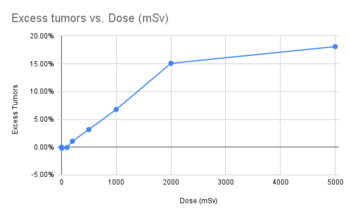Fear of radiation/Debate Guide: Difference between revisions
(create subpage) |
(copy from Discussion page) |
||
| Line 1: | Line 1: | ||
{{subpages}} | |||
{{TOC|right}} | |||
Nuclear power is a controversial topic, and some of the controversies remain unsettled, even after the facts in the article are agreed on. This '''Debate Guide''' will provide a concise summary from each side of these unsettled issues. Much of this discussion is collected from Internet forums and other unreliable sources. We welcome updates with better sourcing. | |||
== LNT Controversy == | |||
{{Image|LNT Data.png|right|350px|Fig.A The data for Fig.1}} | |||
There is endless debate in social media over whether the Linear No Threshold (LNT) model should be used for accessing public health risks from low levels of radiation. Fig.A is the data of Fig.1 from a 52 year study of Japanese bomb survivors, with added columns for a linear fit and for the predicted excess tumors. | |||
{{Image|Excess tumors vs. Dose (mSv).png|right|350px|Fig.B Linear plot of the data}} | |||
Fig.B is the data re-plotted on a linear scale. | |||
The LNT model is a good fit for exposures above 200mSv, ignoring the highest point, where we might expect some kind of saturation. (A better fit would have the threshold at 100mSv, not zero.) | |||
The controversy is over exposures less than 200mSv. If your exposure is between 5 and 100mSv, LNT predicts your chances of getting cancer are 0.75% higher than the normal 21%. The data from this study shows -0.07% (less cancer, not more). | |||
Revision as of 12:22, 10 May 2023
Nuclear power is a controversial topic, and some of the controversies remain unsettled, even after the facts in the article are agreed on. This Debate Guide will provide a concise summary from each side of these unsettled issues. Much of this discussion is collected from Internet forums and other unreliable sources. We welcome updates with better sourcing.
LNT Controversy
There is endless debate in social media over whether the Linear No Threshold (LNT) model should be used for accessing public health risks from low levels of radiation. Fig.A is the data of Fig.1 from a 52 year study of Japanese bomb survivors, with added columns for a linear fit and for the predicted excess tumors.
Fig.B is the data re-plotted on a linear scale.
The LNT model is a good fit for exposures above 200mSv, ignoring the highest point, where we might expect some kind of saturation. (A better fit would have the threshold at 100mSv, not zero.)
The controversy is over exposures less than 200mSv. If your exposure is between 5 and 100mSv, LNT predicts your chances of getting cancer are 0.75% higher than the normal 21%. The data from this study shows -0.07% (less cancer, not more).

